Computer Graphics Survey
Application Basics and Text Entry
Using PageMaker 6.0 on MacOS 8 Computers
|
previous handout |
ACG Home |
Instructor Home |
Class Home |
list of tutorials |
next handout |
Before beginning the project
If you are working in the ACG Lab
click to read these important notes before you start the tutorial.
This section of the directions contains information that pertains specifically to the way the ACG Lab operates. It may not apply if you work on the project elsewhere.
- Adobe PageMaker is one of the two most widely used page layout programs (the other one being QuarkXPress). It was first released by the Aldus corporation in the summer of 1985, marking the beginning of desktop publishing. Adobe purchased Aldus in 1995 and in recent upgrades added several tools for
electronic publishing, besides updating the traditional print media features. This is especially useful for people looking to repurpose existing material for the World-Wide Web.
return to top
- Start up (or wake up) the computer.
- If the computer was sleeping, it will be immediately ready to work. To ensure that enough memory is available, use the icon menu at the very end of the menu bar, on the right (Application Menu) to check that only the 'Finder' is running.
- If other programs appear in the Application Menu, you can choose their names in turn to activate them, then use the Quit command in their File menu to terminate them.
- Find/create a convenient storage location for your work
- While working on your project, you will want to make use of the fastest storage device hooked up to your computer, the hard drive. This is typically also the startup disk, and consequently appears at the top-right corner of the desktop.
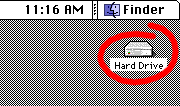
- This is still useful even if at the end of the project you will need to copy your files to a removable device (such as a Zip disk) to take your work with you. The slightly longer set-up and strike-down procedures are more than offset by the amount of time saved while working.
- You also want to be able to access quickly the storage location. The most convenient place is right on the desktop, because it is only one click away in both the Open and Save dialog boxes.
- To create a folder on the desktop for your work, click once on any desktop icon (the startup disk will do) to select it, then use the Finder's File-->New Folder command.
- Find and launch the program PageMaker.

- If you are unsure about PageMaker's location on the hard drive, you can search for it using the Sherlock program (in the Apple menu).
- Use the File-->New command to create a blank new document. You can leave the Document Setup settings at the default values by clicking OK.
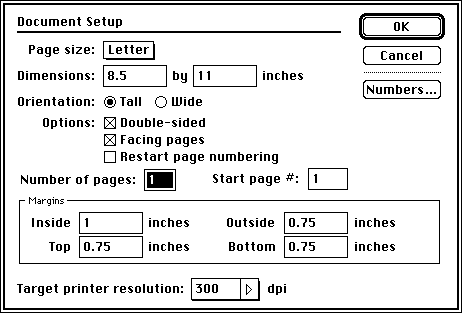
- Immediately copy your document to disk for safekeeping, using the menu command File-->Save. The recommended location for this and other documents is in the folder that you created on the desktop.
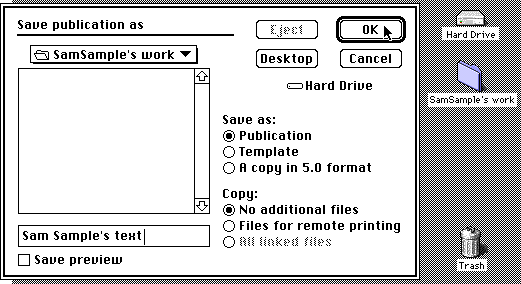
- Remember to use File-->Save early and often from now on to keep your work from disappearing should disaster strike.
return to top
- Click on the the Text tool (marked with a capital 'T" in the toolbox).

- Drag to draw a box within the document window. This creates a text column--a portion of the page where you can put type.

- The box disappears as soon as you release the mouse button. You will see a flashing bar where the upper-left corner of the box was--this is the text insertion point (the location where anything you type will be placed). Go ahead and start entering the text for your web page.
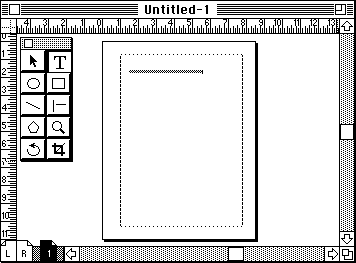
- Notice that the type is very small. It is so small that PageMaker replaces it with a grey bar (called greeking) instead of wasting time displaying type you could not read anyway. To read your type, change the display magnification using Layout-->View-->Actual Size.

- You are currently looking at the Layout View of your PageMaker document. For more convenient text entry, switch to the Story Editor using Edit-->Edit Story. You can return to the Layout View at any time by closing the Story Editor window. The story Editor also makes available commands to check spelling and to search and replace text (both in the Utilities menu).
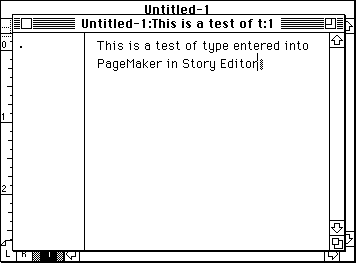
- You may find you need to type letters and symbols not imprinted on the keys of the keyboard. In particular, you may need to enter text in some languages other than English. Additional letters and special symbols are available from the Macintosh extended character set.
- When deciding on what to type, bear in mind that the layout of your web page will be quite simple (text and images will be stacked, not side-by-side). Also, many formatting commands will be lost in the conversion to HTML. Wait until the next handout to format your text--at that time we'll find out which commands are appropriate for your web page.
- Since most of your text will be in a single page, it is a good idea to provide a list of topics at the top of the page. This will become the table of contents (TOC) for your page, making navigation easier.
- The instructions for linking the table of contents to the appropriate section of your web page will be in a later handout.
return to top
- Selecting Text
- In general, Macintosh software requires that you first select an item (such as a piece of text); then use a menu command or tool to alter the selected item.
- The simplest way to select text is to drag the Text tool over it:
- Make sure the Text ('T') tool is selected in the toolbox.
- Click and hold the mouse button at the beginning of the text to be selected.
- While holding down the mouse button, move the pointer to the end of the text to be selected. Note that you don't have to drag across each line of text--you can simply drag down or up to your destination.
- Release the mouse button, leaving the text highlighted. Highlighting appears either as reverse type (white on black), or as a colored background for the type, depending on the settings in the Appearance control panel.
- A faster way to select specific text elements is through multiple clicks of the text tool:
- Virtually all programs support double-clicking on a word to select it (double-clicking is two clicks in rapid succession at the same location).
- Some programs will also support triple-, quadruple-, quintuple-clicking to select entire lines, paragraphs, or stories (a series of linked paragraphs).
- When selecting a very large amount of text (several pages), dragging while selecting can be very slow. Instead, use the Shift key to extend the selection:
- Click the mouse button at the beginning of the text to be selected.
- While pressing the Shift key, click the mouse button at the end of the text to be selected. All the text between the locations of the first and the second click will be highlighted.
- Shift-clicking can also be used to extend or reduce an existing selection.
- Erasing
- Once text is selected, it can be modified in various ways--including its total elimination by pressing the <Delete> key, or choosing Clear from the Edit menu.
- To delete characters to the left of the insertion point (flashing bar), also press the <Delete> key.
- To delete characters to the right of the insertion point, press the <Del> key, located above the cursor (arrow) keys. This is not supported by all programs, and not available on all keyboards.
- Replacing
- Select text to be replaced, then type replacement text.
- Moving and replicating
- The process of re-arranging text is commonly accomplished by cutting and pasting through the Clipboard.
- The first step in cut-and-paste involves placing the selected text on the Clipboard. This is accomplished by two commands found in the Edit menu: Cut and Copy.
- The difference between Cut and Copy is that the former removes the selection from its original location, while the latter leaves a copy behind.
- Once the text is on the Clipboard, you can reposition the insertion point by clicking at the new location with the Text tool. Finally, the Paste command in the Edit menu will retrieve the content of the clipboard and place it at the insertion point.
- Pasting does not remove the item from the Clipboard, so it can be pasted multiple times. However, any use of the Cut or Copy commands will displace whatever is currently on the Clipboard.
- Since the commands for cut-and-paste are used frequently, you might want to note their keyboard equivalents:
- Command-X for Cut
- Command-C for Copy
- Command-V for Paste
- These keyboard commands, as well as Command-Z for Undo, are standard across all Macintosh applications.
return to top
- When done, use File-->Quit to exit PageMaker.
- If no other programs were running on the computer, you will be returned to the Finder. Otherwise, you may have to select the Finder from the Application menu (the icon at the far right of the menu bar).
- Back up your file
- Insert a Macintosh-formatted Zip disk (metal shutter forward, label side up) into the slot in the blue Zip drive connected to your computer.
- Shortly afterwards, a Zip disk icon will appear on the desktop.

- If the Zip disk icon has 'PC' on it, you will want to reformat it as a Macintosh disk (Caution: this will wipe out anything currently on the disk). Otherwise, the disk is ready to use.
- To reformat the Zip disk, first make sure that File Sharing is turned off (use the Control Strip--the tab protruding from the edge of the screen: the folder icon should have no wires attached to it).

- Next, find and launch the Tools program, part of the Iomegaware set of Zip utilities.

- In the Tools program window, click the Erase button.

- In the Erase dialog window, choose Mac OS Standard from the Format pop-up menu.

- Finally, still in the Erase dialog window, click the Short Erase button.

When done erasing, the Zip disk should re-appear on the desktop with the mac-format icon. You can then quit the Tools program, and turn File Sharing back on.
- Drag the icon of your folder on the desktop (containing your file) to the Zip disk icon. A message with a progress bar will appear, reporting that your folder and file are being read off the hard drive and written to the Zip disk.
- When the copy completes, drag the Zip disk icon to the Trash icon. This ejects the disk and removes its icon from the desktop.
- To ward against possible accidents, repeat the same steps to copy your folder and file to a second backup disk.
- Shut down or send to sleep the computer
- Both commands are in the Special menu of the Finder.
return to top
- Online help for PageMaker is available through the Help menu.
- Adobe maintains a PageMaker help page on the web.
return to top
Notes
- In the mid-80s, along with the introduction, at approximately the same time, of the Apple Macintosh and Adobe's PostScript page description language (incorporated in the original Apple LaserWriter), the program PageMaker gave impetus to the use of inexpensive computers for graphic design applications.
- The name Desktop Publishing (DTP) highlights the extensive control over the publishing workflow given to the designer, at his/her studio. In traditional publishing, the designer would use the services of many different businesses in the course of designing and producing a layout. This resulted in delays, increased costs, and fewer creative opportunities. As DTP evolved, more and more of these services were brought in-house and condensed into powerful programs such as PageMaker.
return
- Indicates the circulation of information as computer files. Instead of being printed and distributed on paper, text and graphics are output as HTML Web Pages, Acrobat Portable Documents, and other formats--and viewed directly on the computer screen.
- Some of the benfits deriving from this approach are:
- Much shorter lead time for revisions. In effect, the notion of periodic issues often disappears, as a web site can be updated on a continuous basis.
- Generally lower upfront costs. Economies of scale (large print runs) are no longer needed to bring down a unit cost which, for web page hits, is essentially negligible. Ease of workflow automation may also lower operating costs.
- Ease of customization of the final product, potentially yielding a unique experience for each individual user. Viewers themselves have extensive control over what they see and how they see it.
- Far-reaching circulation at little or no extra cost. A compact disc condenses reams of paper into a highly portable object. A web site automatically acquires a global reach.
- Greater variety of communication modes--besides text and still images, electronic publications can incorporate motion pictures, sound, three-dimensional simulations, and interactive elements.
- Against these benefits, electronic publishing still suffers from a relatively small potential audience--due to the equipment, skills, and access required of viewers. This small audience is often further fragmented by divergent industry standards.
return
- Besides cut-and-paste, several programs support drag-and-drop text editing as well.
- You can tell that drag-and-drop is available by placing the pointer on top of highlighted text: if the I-beam turns to an arrow, you can drag-and-drop the text selection.
- To move text with drag-and-drop, simply click and hold the mouse button when the arrow pointer is over the selected text, then drag to the new location. As the pointer moves, the insertion bar will move as well to indicate the exact location of dropped text. Release the mouse button to drop the text.
- To copy text with drag-and-drop, follow the same process described for moving, but keep the Option key pressed. Make sure to release the mouse button before releasing the Option key.
return
- The characters (letters, numbers, punctuation, and other symbols) available to type with are called the character set of the computer.
- The most widely used standard for character sets is called ASCII. Because of various historical circumstances, the ASCII standard only specifies a set of 128 characters, while the character sets used by current computer systems comprise twice as many characters.
- The character set for a given type of computer remains consistent for most text typefaces. Display, ornamental, and other special fonts may have character sets of their own.
- The characters on any given computer system which are not covered by the ASCII standard (i.e., the second group of 128 characters) is called the extended character set for that computer.
- An unfortunate consequence of the inadequate scope of the ASCII standard is that characters in the extended set will change from computer to computer. Even if the same character is available on different computers, it is likely encoded in incompatible ways on each of them.
- Because of this incompatibility, text that may be read on many different computers (such as e-mail and web pages) should contain only characters from the ASCII set (unless additional steps are taken to ensure the proper conversion between different encodings).
- The significance of the extended character set is that, in addition to providing additional symbols for purposes such as math formulas and currencies, it contains the letters needed to enter text in a number of other languages (besides English) which use the Latin alphabet.
- The languages using the Latin alphabet are mostly those originating in Western Europe. This means that even the extended character set is inadequate to represent many of the world's languages, especially those requiring a very large number of characters (such as the languages of China). A new standard called Unicode solves this problem by specifying many thousands of characters in all known alphabets.
- Unicode is still not widely implemented in current computer systems. The ASCII standard remains the only standard usable with virtually all software.
- On Macintoshes, you can find out how to type any one character (including those in the extended character set) by using the Key Caps program (available through the Apple menu).
- The Key Caps window shows a diagram of the keyboard currently connected to the computer. When modifier keys are pressed, alone or in combination, the diagram changes to show the characters accessed through those modifiers.
- Most characters can be obtained by holding down some combination of modifier keys and pressing an additional key. For some letters with diacriticals (letters with special marks above them, such as 'ñ' and 'Ü'), a two-step technique called dead keys is used:
- Hold down the Option key and look for the keys surrounded by a checkerboard border, for instance '~' (which is in the same location where 'n' is when all modifiers are released).
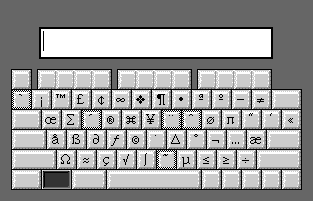
- While holding Option down, press the key with the diacritical. Notice that no text appears.
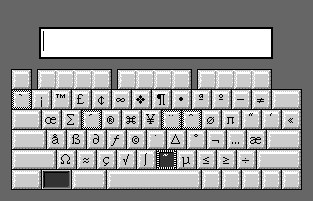
- Release the Option key. All the letters that can be typed in conjunction with the diacritical mark you pressed earlier appear highlighted.
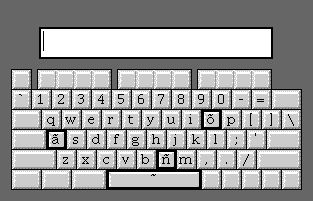
- Complete the process by pressing the key with diacritical you require. Only now a character is added to the text.
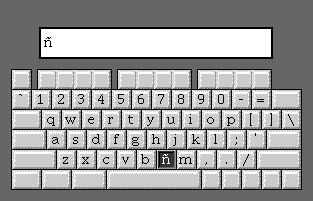
- The highlighted letters can be capitalized (retaining the diacritical mark) by using the Shift key.
- The completion of the dead-key entry resets the keyboard, and the letters with diacriticals are replaced by their plain counterparts.
- To see how character sets vary from font to font, choose a typeface from the Key Caps menu.
- In rare instances, some characters of the same typeface may change as the type size changes. This cannot be seen in Key Caps, which always shows the same size characters.
return
Information specific to the ACG Lab
- On ACG Lab computers, the program PageMaker is on the hard drive, inside the DTP folder.
- On ACG Lab computers, the Tools program to format Zip disks is on the hard drive, inside the Utilities folder.
- In the ACG Lab, documentation on PageMaker is on the ACG_DOCS volume of the ACG file server, inside the PageMaker folder:
- Select 'Chooser' from the Apple menu
- In the Chooser window, click on the 'AppleShare' icon on the left; double-click 'ACG' in the list of servers which appears on the right.
- Enter the name and password specified by the instructor in class; click 'OK'.
- Double-click 'ACG_DOCS' in the list of volumes; the icon for ACG_DOCS will appear on the desktop of your computer.
- Close the Chooser window.
- If you do not have a Zip disk for saving yor file, make sure to contact the instructor before you leave. Never walk away from a lab computer leaving your files on the hard drive--they will soon be deleted.
- Detailed instruction on all aspects of PageMaker's use is available through the Art Computer Graphics program of Fullerton College in course ACG140-Desktop Publishing I. Look it up in the ACG Class Schedule.
return
|
previous handout |
return to top |
next handout |
|
This document originally at <http://acg2.fullcoll.edu/FACULTY/CORSI/LEARN/OVERVIEW/OV020/MAC1EN_P.HTM>
|
Copyright 1998-99 by Sandro Corsi.
Last modified 2000-01-26.
|
SaneDraw home
|